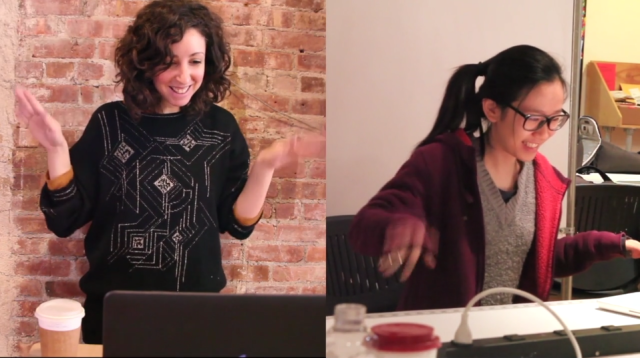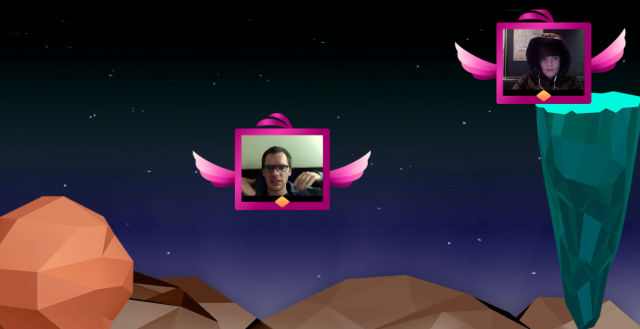Via Creative Applications
-----
By Lauren McCarthy & Kyle McDonald

AIT (“Social Hacking”), taught for the first time this semester by Lauren McCarthy and Kyle McDonald at NYU’s ITP, explored the structures and systems of social interactions, identity, and self representation as mediated by technology. The semester was spent developing projects that altered or disrupted social space in an attempt to reveal existing patterns or truths about our experiences and technologies, and possibilities for richer interactions.
The class began by exploring the idea of “social glitch”, drawing on ideas from glitch theory, social psychology, and sociology, including Harold Garfinkel’s breaching experiments, Stanley Milgram’s subway experiments, and Erving Goffman’s dramaturgical analysis of social interaction. If “glitch” describes when a system breaks down and reveals something about its structure or self in the process, what might this look like in the context of social space?
Bill Lindmeier wrote a Ruby script using the Twitter Stream API to listen for any Tweets containing “new profile pic.” When a Tweet was posted the script would download the user’s profile image, upload it to his own account and then reply to the user with a randomly selected Tweet, like “awesome pic!”. The reactions ranged from humored to furious.

Along similar lines, Ilwon Yoon implemented a script that searched for Tweets containing “I am all alone” and replied with cute images obtained from a Google image search and “you are not alone” text.
Mack Howell built on the in-class exercise of asking strangers to borrow their phone then doing something unexpected with it, asking to take pictures of strangers’ browsing history.

The class next turned it’s attention to social automation and APIs, and the potential for their creative misuse.
Gal Sasson used the Amazon Mechanical Turk API to create collaborative noise, creating a chain where each turker was prompted to replicate a drawing from the previous turker, seeding the first turker with a perfect square.

Mack Howell used the Google Street View Image API to map out the traceroutes from his location to the data centers of the his most frequently visited IPs.
In another assignment, students were prompted to create an “HPI” (human programming interface) that allowed others to control some aspect of their lives, and perform the experiment for one full week.
Anytime an email or Twitter direct message was sent to Ben Kauffman with the hashtag #brainstamp and a mailing address, he would get an SMS with the information and promptly right down on a postcard whatever was in his head at that exact moment. He would then mail the thoughts, at turns surreal and mundane, to the awaiting recipient. An alternative to normal social media, Ben challenged us to find ways to be more present while documenting our lives.


Bill Lindmeier invited his friends to control his movements in realtime through a Google-street-view-esque video interface, and asked them to complete a simple mission: Buy some coffee in under 20 minutes. The tools at their disposal: $5, an umbrella and a carrot.

Mack Howell created a journal written by Amazon Mechanical Turk workers, asking them to generate diary entries based on OpenPaths data sent automatically as he moved around.

In a project called My Friends Complete Me, Su Hyun Kim posted binary questions on Facebook, Twitter and Instagram, and let her friends collective opinion determine her life choices, including deciding whether to change her last name when she got married.
A couple weeks were spent having focused discussions about security, privacy, and surveillance, including topics like quantified self, government surveillance and historical regimes of naming, and readings from Bruce Schneier, Evgeny Morozov and Steve Mann. In parallel, students were asked to examine their own social lives and compulsively document, share, intercept, impersonate, anonymize and misinterpret.
Mike Allison explored our voyeuristic nature and cultural craving for surveillance, allowing users to watch someone watch someone who may be watching them. In order to watch, users must lend their own camera to the system.
Bill Lindmeier created an app called File Party, a repository of files that have been randomly selected and uploaded from peoples’ hard-drive. In order to view the files, you have to upload one yourself.


In a unit on computer vision and linguistic analysis, students were paired up and asked to create a chat application that provided a filter or adapter that improved their interaction.
Realizing how much is lost in translation and accents, Tarana Gupta and Hanbyul Jo developed a video chat tool which allows users to talk in their respective language and and displays in real-time text and images corresponding to what is being said.

In FlapChat, Su Hyun Kim and Gal Sasson rethought the way we interact with the web camera, allowing users to flap their arms to fly around a virtual environment while chatting.


Overall, the most successful moments in the class were the ones where students had an opportunity to examine an otherwise common technology or interaction from a new perspective. Short in-class exercises like “ask a stranger to use their phone, and do something unexpected” gave students a reference point for discussion. The “HPI” assignment gave students an unusual challenge of “performing” something for a week, lead to its own set of difficulties and realizations that are distinct from purely technical or aesthetic exercises. On the first day of class a contract was handed out requiring that students respect others’ positions in class, and take responsibility for any actions outside of class. This created a unfamiliar atmosphere and opened up the students to question their freedoms and responsibilities towards each other.
In the future, each two- or three-week section might be expanded to fit a whole semester. Of particular interest were the computer vision, security and surveillance, and mobile platforms sections. Leftover discussion from security and surveillance spilled into the next week, and assignments for mobile platforms could have been taken far beyond the proof-of-concept or design-only stages.
More information about the class, including the complete syllabus, reading lists, and some example code, is available on GitHub.
A condensed version of this class will be taught in January at GAFFTA in San Francisco, details will be announced soon with more information here.
About the Tutors:
Kyle McDonald is a media artist who works with code, with a background in philosophy and computer science. He creates intricate systems with playful realizations, sharing the source and challenging others to create and contribute. Kyle is a regular collaborator on arts-engineering initiatives such as openFrameworks, having developed a number of extensions which provide connectivity to powerful image processing and computer vision libraries. For the past few years, Kyle has applied these techniques to problems in 3D sensing, for interaction and visualization, starting with structured light techniques, and later the Kinect. Kyle’s work ranges from hyper-formal glitch experiments to tactical and interrogative installations and performance. He was recently Guest Researcher in residence at the Yamaguchi Center for Arts and Media, Japan, and is currently adjunct professor at ITP.
http://kylemcdonald.net
Lauren McCarthy is an artist and programmer based in Brooklyn, NY. She is adjunct faculty at RISD and NYU ITP, and a current resident at Eyebeam. She holds an MFA from UCLA and a BS Computer Science and BS Art and Design from MIT. Her work explores the structures and systems of social interactions, identity, and self-representation, and the potential for technology to mediate, manipulate, and evolve these interactions. She is fascinated by the slightly uncomfortable moments when patterns are shifted, expectations are broken, and participants become aware of the system. Her artwork has been shown in a variety of contexts, including the Conflux Festival, SIGGRAPH, LACMA, the Japan Media Arts Festival, the File Festival, the WIRED Store, and probably to you without you knowing it at some point while interacting with her.
http://lauren-mccarthy.com












